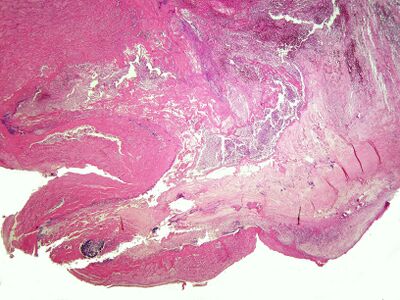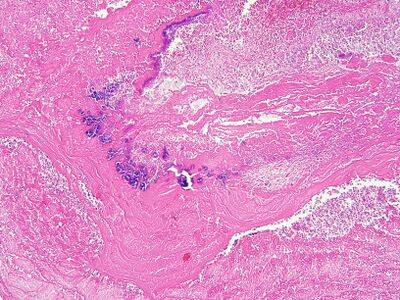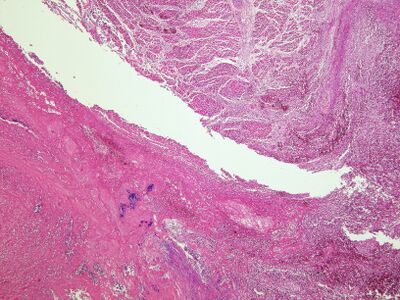Bacterial Endocarditis (histological slide)
Histology[edit | edit source]
Cause[edit | edit source]
Infection caused by staphylococci (30-50 %), streptococci, pneumococci, enterococci, Gram-negative anaerobic rods and cocci (E.coli) and others.
Pathogenesis[edit | edit source]
It occurs in a heart both normal and with a previously altered endocardium (congenital malformations, acquired valvular defects, but also conditions after diagnostic or therapeutic procedures on the heart). Infection often occurs in immunodeficient states, neutropenia, immunosupresion and intravenous drug addiction. A necessary condition for the development of bacterial endocarditis is the penetration of an infectious agent into the blood (bacteremia). The agent settles on the valve, leads to the formation of a thrombus, in which it multiplies.
Macroscopy[edit | edit source]
On the flaps there are vegetations of irregular shape, fragile, from a few mm to 2-3 cm, mostly brown-red in color. They tend to be located on the inflow surface of the left-sided heart valves (90% of cases), and can be multiple.
Microscopy[edit | edit source]
The thrombus consists mainly of fibrin, in which are scattered multiple colonies of microorganisms (staphylococci) with leukocyte infiltrate. A thrombus can be organized to varying degrees by granulation tissue (healing). Leukocyte infiltration and necrosis are usually present in the adjacent valve .
Prognosis and complications[edit | edit source]
There is a risk of impaired function of the affected valve (formation of voluminous vegetation narrowing the lumen, local spread of inflammation, necrosis with ulceration, perforation or rupture and subsequent non-closing), embolization of infected thrombus fragments (septicopemia and the formation of abscesses in various organs, most often in the brain, kidneys, myocardium and skin ). Furthermore, immunocomplex impairment (local vasculitis).
Occurence[edit | edit source]
Often in immunodeficient states, immunosuppressed patients and intravenous drug addicts.
Related articles[edit | edit source]
- Heart
- Infectious endocarditis
- Infectious endocarditis (pediatry)
- Endocarditis
- Non-infectious endocarditis
- Congenital cardial malformations
External links[edit | edit source]
Bibliography[edit | edit source]
- POVÝŠIL, Ctibor – ŠTEINER, Ivo – BARTONÍČEK, Jan, et al. Speciální patologie. 2. edition. Praha : Galén, 2007. 430 pp. ISBN 978-807262-494-2.
- BRYCHTOVÁ, Svetlana – HLOBILKOVÁ, Alice. Histopatologický atlas. 1. edition. Praha : Grada, 2008. 112 pp. ISBN 978-80-247-1650-3.



